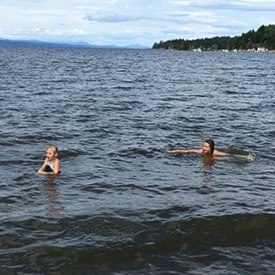Barbara Latkowski
Caledonia Courier
It’s summer and of course it’s the time for kids to enjoy time to cool off and have fun splashing about in local lakes.
But every so often, once out of the water, a child can experience a sudden itch followed by a rash.
Swimmers itch otherwise known as duckage, isn’t uncommon.
But what causes this condition and how can it be avoided?
According to Healthlink BC, swimmer's itch is a temporary, itchy rash caused by small worm-like parasites called schistosomes (shiss-toe-soams). Schistosomes spend their life cycle as parasites in the bodies of water snails and in the blood stream of aquatic mammals, ducks or other waterfowl. During their life cycle, schistosome larvae leave their snail host and swim near the surface of the water, looking for bird and mammal hosts.
How can one get swimmer’s itch?
Sometimes larvae might mistakenly get on your skin if you are swimming or wading in water. The larvae burrow under your skin, however, they cannot survive in humans and will die almost immediately. It is the allergic reaction to these tiny larvae under the skin that causes swimmer’s itch.
Swimmer's itch cannot be spread from person to person.
Where are these parasites found?
These parasites can be found in many lakes, ponds, and coastal waters in British Columbia usually in the warm summer months. Wind near the shoreline can push the tiny larvae to the edges of lakes where they float near the surface.
Although not very common, cases of swimmer's itch have also been reported on coastal beaches in B.C. – a result of a species of snail from the Atlantic coast.
Who has a higher risk of getting swimmer’s itch?
Young children who wade and splash in shallow areas of lakes and ponds may be at higher risk because:
- They are constantly getting wet, without thoroughly drying off.
- They usually play by the shore where these parasites tend to be.
- Younger children’s skin can be more sensitive than the skin of an adult.
How can swimmer's itch be avoided?
There is no sure way to avoid swimmer's itch entirely, unless you avoid lakes, ponds, or beaches. However, there are certain precautions you can take, including:
- Speaking with other visitors to the area, local health officials, or parks representatives about the water condition before getting in any lake, pond or beach.
- Checking for warning signs at public beaches, lakes and picnic areas that state that swimmer’s itch may be present. Not all beaches have signage for swimmer's itch. If you are unsure about the water, avoid areas with lots of weed growth. There may be more snails and larvae around plants.
- Using a pier or dock to enter the water may help reduce your risk of exposure, as there tend to be more larvae near the shore. Make sure these structures are approved for swimming and do not dive into unknown waters. See HealthLinkBC File #39 Safety Tips for Swimmers or contact the Lifesaving Society atwww.lifesaving.bc.ca for more information on swimming safety and drowning prevention.
- Applying waterproof sunscreen and/or baby oil before bathing may help reduce the number of larvae from penetrating your skin.
- Drying yourself off with a towel as soon as you come out of the water. If possible, have a shower and dry off right away. Showering will not remove any larvae that have already burrowed under your skin.
What are the symptoms?
Symptoms can range from a mild irritation to a very severe, itchy red rash. Scratching can cause severe pain and swelling, or cause your skin to become infected. The severity of your symptoms will depend on how many larvae get on to your skin, and how sensitive you are to them. Symptoms also tend to get worse after repeat exposure.
As you start to dry off and the larvae start to burrow into your skin, you may feel a tingling sensation. Small, pin sized red spots will appear which grow into larger red rashes within several hours. As these red spots grow, the tingling feeling becomes a strong itch.
How long do the symptoms last?
A rash may appear within 12 hours after infection. The infection may last from 2 to 5 days and symptoms can last as long as 2 weeks.
Repeat infections are usually worse because people become more sensitive to the larvae and develop stronger allergic responses each time.
How is swimmer's itch treated?
There are a number of steps you can take, which may reduce some of the itchiness. Check with your health care provider about what treatment is right for you.
Common treatments and advice include:
- Avoid scratching, if you scratch too much the rash may become infected.
- Apply plain calamine lotion.
- Take antihistamines. For children under 6-years-old, consult your health care provider such as your local pharmacist, family doctor or HealthLinkBC. Antihistamines may make young children sleepy or may stimulate the nervous system causing hyperactivity.
- Take shallow, lukewarm baths with 3 tablespoons of baking soda in the water.
- Take colloidal oatmeal baths.
- Apply cool compresses.
Is swimmer's itch dangerous?
The rash and itch can be very irritating, especially for young children, but there should not be any serious danger. However, if a skin infection occurs from too much scratching, you should see your health care provider.
For more information on swimmer's itch visit: http://www.healthlinkbc.ca/healthfiles/hfile52.stm
